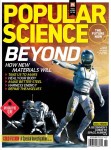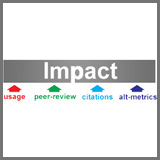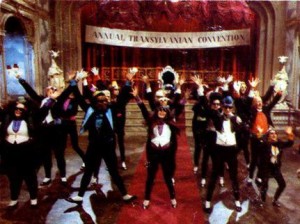 In the atmosphere, soot traps heat like carbon dioxide does. But unlike CO2, soot stays near its source and falls to Earth in weeks, so it’s considered low-hanging fruit in the fight against global warming. The first step to reducing atmospheric soot is to find it, which scientists have been doing since the 1980s with a particle-measuring tool called an aethalometer. Continue reading The Soot Surveyor
In the atmosphere, soot traps heat like carbon dioxide does. But unlike CO2, soot stays near its source and falls to Earth in weeks, so it’s considered low-hanging fruit in the fight against global warming. The first step to reducing atmospheric soot is to find it, which scientists have been doing since the 1980s with a particle-measuring tool called an aethalometer. Continue reading The Soot Surveyor
Category Archives: Outlets
Alternative Research Metrics
 Most scientific researchers know the agony of waiting to hear about the status of a submitted manuscript. They are eager to change the phrase “manuscript submitted” on a grant application or curriculum vitae to “in press” in advance of some crucial deadline. Publications in prestigious journals—not necessarily the articles themselves but the fact of their existence—are the established and universal, albeit imperfect, way of claiming credit for the scientific work you’ve done, and there’s always a delay.
Most scientific researchers know the agony of waiting to hear about the status of a submitted manuscript. They are eager to change the phrase “manuscript submitted” on a grant application or curriculum vitae to “in press” in advance of some crucial deadline. Publications in prestigious journals—not necessarily the articles themselves but the fact of their existence—are the established and universal, albeit imperfect, way of claiming credit for the scientific work you’ve done, and there’s always a delay.
But when sociologist Margarita Mooney of the University of North Carolina, Chapel Hill, recently applied for a grant, she was able to take instant credit for one aspect of her work: the readership of her blog, as documented by Google Analytics. When she told the review committee that her team blog, Black, White and Gray, had 15,000 page views in its first month, rising to 20,000 views in later months, they were impressed, she recalls. Blog readership is not a traditional measure of scholarship, but the committee, which was also evaluating public impact, rewarded her for it. She won the grant.
Ice may lurk in shadows beyond Moon’s poles
Water ice on the moon may be more widespread than previously thought. Permanent shadows have been spotted far from the lunar poles, expanding the number of sites that would be good candidates for exploration by robotic rovers — or even for the locations of lunar bases.
Researchers have known for decades that the Moon’s poles host craters with lofty rims that shield their floors from sunlight, so searches for shadowed areas harbouring water ice have focused on the poles. But over the past few months, researchers have built a catalogue of permanently shadowed regions elsewhere on the Moon.
Continue reading Ice may lurk in shadows beyond Moon’s poles
Machine Vision Sees Into Chickens’ Futures
 A jump to the left and a step to the right are signs of healthy activity, as chicken farmers who stroll among their flocks already know. Now a team led by robotics engineer Stephen Roberts at the University of Oxford has found that patterns in the collective motion of a flock of chickens can help farmers predict disease weeks before onset. Call it a chicken time warp.
A jump to the left and a step to the right are signs of healthy activity, as chicken farmers who stroll among their flocks already know. Now a team led by robotics engineer Stephen Roberts at the University of Oxford has found that patterns in the collective motion of a flock of chickens can help farmers predict disease weeks before onset. Call it a chicken time warp.
Roberts and animal-welfare researchers at Oxford first tested their pattern-detection system by asking it to warn farmers before a flock got “peckish.” That’s not a euphemism for “hungry.” Well-fed hens, it turns out, sometimes take out their worm-hunting instincts on one another. The system, which consisted of cameras recording a flock, followed by computer analysis of the footage, beat human experts at flagging the at-risk flocks before the madness took its toll [“Computer System Counters Hen Horrors,” September 2010].
Read the rest of this news story in IEEE Spectrum [html] [pdf]